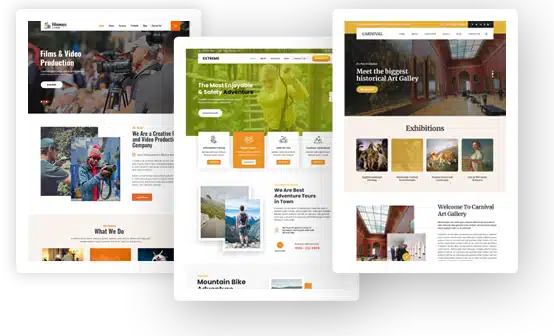5 Must-Use CSS Frameworks for Web Design
CSS frameworks play a vital role in modern web design, offering developers a range of pre-built components, styles, and layouts that streamline the development process. These frameworks have become indispensable tools for designers and developers alike, providing a solid foundation for creating responsive and visually appealing websites. By utilizing CSS frameworks, developers can save valuable time and effort, focusing more on the creative aspects of design rather than starting from scratch.
Importance of choosing the right CSS Framework
Choosing the right CSS framework is crucial for ensuring efficient and effective web design. Each framework has its own unique features, strengths, and considerations. Developers can optimize their workflow, enhance code maintainability, and improve overall productivity by selecting a framework that aligns with the specific project requirements. Factors such as customization options, documentation, community support, responsiveness, browser compatibility, and learning curve should be carefully considered when making this decision.

The following sections will explore five must-use CSS frameworks that have gained significant popularity in the web design community. These frameworks offer a wide range of features and advantages, catering to different design preferences and development needs. Whether you’re a seasoned developer or just starting out, these CSS frameworks are essential tools that can significantly enhance your web design projects.
What are CSS Frameworks?
CSS frameworks are pre-written sets of CSS code that provide a foundation for building websites. They consist of a collection of predefined styles, components, and layout grids that developers can utilize to streamline the web development process. CSS frameworks aim to simplify and standardize the design and styling aspects of websites, allowing developers to focus more on the functionality and specific features of the site.
CSS frameworks play a crucial role in web development by providing a structured approach to design implementation. They offer a set of ready-to-use classes and styles that can be easily applied to HTML elements, eliminating the need for developers to start from scratch and write extensive CSS code for every aspect of a website. This saves time and ensures consistency across different pages and sections of the site.
One of the key advantages of using CSS frameworks is their ability to facilitate responsive design. With the increasing variety of devices and screen sizes, it has become essential for websites to adapt seamlessly to different environments. CSS frameworks often include responsive grid systems that allow developers to create flexible and fluid layouts. These grid systems enable the design to adjust and reposition elements based on the screen size, ensuring optimal user experience across various devices.

Using a lightweight CSS framework also offers significant advantages in terms of faster development and code maintenance. By leveraging pre-built components and styles, developers can expedite the process of creating a website without compromising quality. The availability of predefined styles and classes reduces the amount of custom CSS code that needs to be written, resulting in a more efficient workflow. Moreover, a modern CSS framework typically adheres to best practices and coding standards, which makes the codebase more organized and easier to maintain in the long run. Updates and modifications can be applied more seamlessly, reducing the risk of introducing errors or inconsistencies.
Factors to Consider When Choosing a CSS Framework
When selecting a CSS framework for your web design projects, it’s important to consider several key factors that can impact your development process and the final outcome of your website. Here are the main considerations to keep in mind:
-
Flexibility and Customization Options
Evaluate the level of flexibility and customization options offered by the CSS framework. Can you easily modify the styles and components to match your specific design requirements? Look for frameworks that allow for easy customization without sacrificing ease of use.
-
Documentation and Community Support
Check the availability and quality of documentation provided by the CSS framework. Good documentation can help you understand how to use the framework effectively and troubleshoot any issues that may arise. Additionally, consider the size and activity of the framework’s community. A supportive and active community can provide valuable resources, tutorials, and assistance when needed.
-
Responsiveness and Cross-Browser Compatibility
Ensure that your CSS framework is designed to create responsive websites that adapt seamlessly to different screen sizes and devices. Look for responsive grid systems and responsive design utilities provided by the framework. It’s also crucial to verify the cross-browser compatibility of the framework to ensure consistent rendering across popular browsers. A minimalist CSS framework helps here.
-
Learning Curve and Developer Familiarity
Consider the learning curve associated with popular CSS frameworks. How quickly can you grasp the concepts and start utilizing the framework effectively? If you or your team are already familiar with a particular framework, it may be advantageous to stick with it to minimize the learning curve. However, don’t be afraid to explore other CSS frameworks if they offer significant benefits that align with your project requirements.
-
Performance and File Size
Assess the performance and file size implications of the CSS framework, including its compatibility with web scraping. Bloated frameworks can negatively impact website loading times, leading to a poor user experience. Look for frameworks that prioritize performance optimization and offer ways to minimize the file size. This ensures that your website remains fast and efficient, even when utilizing the framework’s features and extracting data through web scraping.
Considering these factors, you can make an informed decision when choosing the best CSS framework that best suits your project needs. Each factor plays a crucial role in determining the ease of development, customization capabilities, browser compatibility, learning curve, and overall performance of your website.
Top 5 CSS Frameworks for Web Design
-
Bootstrap
- Bootstrap is a widely-used CSS framework that provides a comprehensive collection of responsive components, styles, and a grid system.
- It offers a mobile-first approach, allowing developers to create websites that are optimized for mobile devices and easily adapt to larger screens.
- Bootstrap includes pre-built components such as navigation bars, buttons, forms, and modals, making creating visually appealing and interactive interfaces easy.
Reasons for Bootstrap’s popularity among developers:
- The responsive grid system provided by Bootstrap enables developers to create flexible and responsive layouts easily.
- Bootstrap has extensive documentation and an active community, providing developers with resources, tutorials, and support.
- It offers flexibility and customization options, allowing developers to customize the framework to suit their specific design needs.
- Bootstrap is compatible with modern browsers, ensuring consistent rendering and functionality across different platforms.
- The framework integrates well with JavaScript components and plugins, making adding interactive elements and enhancing website functionality convenient.
-
Foundation
- Foundation is a CSS framework that focuses on a mobile-first approach and responsive design.
- It offers a responsive grid system that allows developers to create fluid layouts that adapt to different screen sizes and devices.
- Foundation provides a comprehensive set of customizable components and styles, empowering developers to create unique and visually appealing designs.
Unique selling points of Foundation as a CSS framework:
- Foundation emphasizes accessibility and inclusion features, ensuring that websites built with the framework are usable by a wide range of users.
- It includes built-in support for building responsive emails, making it a versatile email design and development framework.
- Foundation integrates seamlessly with popular front-end frameworks like Angular, React, and Vue, offering flexibility and compatibility for development projects.
-
Bulma
- Bulma is a lightweight and modular CSS framework that focuses on simplicity and ease of use.
- It provides a flexbox-based grid system, offering flexibility and efficient layout options.
- Bulma offers an extensive set of UI components such as forms, buttons, cards, and navigation bars, enabling developers to build responsive and attractive interfaces quickly.
Advantages of using Bulma in web design:
- Bulma’s lightweight design makes it easy to use and load quickly, contributing to better website performance.
- The flexbox-based grid system simplifies responsive design and allows for intuitive positioning of elements.
- Bulma provides comprehensive documentation and is beginner-friendly, making it accessible for developers of all skill levels.
- It offers easy customization and theming options, allowing developers to create unique designs that align with their brand or project requirements.
-
Tailwind CSS
- Tailwind CSS is a utility-first CSS framework that focuses on rapid prototyping and efficient development.
- It provides a wide range of utility classes that can be applied directly in HTML, enabling developers to quickly style elements without writing custom CSS code.
- Tailwind CSS is highly customizable and allows for low specificity, offering flexibility in design implementation.
Benefits of using Tailwind CSS in web development:
- The utility-first approach of Tailwind CSS speeds up the prototyping process by providing a vast array of pre-defined utility classes.
- It offers advanced responsive design capabilities, allowing developers to create responsive layouts for different screen sizes easily.
- Tailwind CSS promotes an efficient class-based workflow, making reading, maintaining, and modifying code easier.
- The framework includes extensive utility classes and pre-built components, reducing the need to write custom CSS and enabling faster development.
-
Semantic UI
- Semantic UI is a CSS framework focusing on semantic and intuitive class names, aiming to make development more intuitive and expressive.
- It provides a comprehensive set of UI elements and modules that cover a wide range of design needs.
- Semantic UI offers theming and customization options, allowing developers to create unique designs and tailor the framework to their specific requirements.
Notable features that make Semantic UI a notable CSS framework:
- Semantic UI utilizes semantic and intuitive class names, making it easier for developers to understand and use the framework’s styles and components.
- It provides a wide range of UI elements and modules, including buttons, forms, menus, and cards, allowing for quick and consistent design implementation.
- Semantic UI offers easy theming and customization, enabling developers to create visually appealing and cohesive designs that align with their brand or project.
- The framework supports responsive design, ensuring that websites built with Semantic UI adapt well to different screen sizes and devices.
- Semantic UI has an active community and regular updates, providing ongoing support, bug fixes, and new features to enhance the framework.
These five CSS frameworks, Bootstrap, Foundation, Bulma, Tailwind CSS, and Semantic UI, offer a variety of features and advantages that cater to different design preferences and development needs. Each framework brings its unique strengths to the table, empowering developers to create responsive, visually appealing, and efficient web pages and designs. As a web user, you can finally leave feedback on every website reviews page you visit without experiencing slow responses from the site.

Frequently Asked Questions
Can I customize the styles and components in CSS frameworks?
Yes, the best CSS frameworks generally allow for customization. Most frameworks provide customization options such as variables, mixins, or configuration files to adapt the styles and components to your project’s specific design needs. However, the level of customization may vary between frameworks, so it’s important to review the documentation or guidelines provided by the framework to understand the extent of customization available.
Are CSS frameworks compatible with all browsers?
CSS frameworks aim to be compatible with modern browsers and ensure consistent rendering and functionality across different platforms for developers and designers. However, it’s essential to review the compatibility information provided by the framework and test your website on different browsers to ensure optimal performance and user experience.
Can I use multiple CSS frameworks in the same project?
Using multiple CSS frameworks in a project is technically possible, but it’s generally not recommended due to potential conflicts and increased file sizes. Instead, it’s advisable to choose one CSS framework that best fits your project requirements and leverage its features and components to maintain a consistent and efficient development workflow.
Conclusion
Choosing the right CSS framework is crucial for successful web design projects. Each framework has its own strengths and considerations, making it essential to assess project requirements and align them with the features offered by the framework. By selecting the appropriate CSS framework, developers can optimize their workflow, improve code maintainability, and create visually appealing and responsive websites.
Joe Troyer Author
I’m one of the founders of Virtual Valley. We own and grow profitable bootstrapped ventures that are entirely bootstrapped and funded by customers, forcing us to focus on building products that customers, not investors, love.

